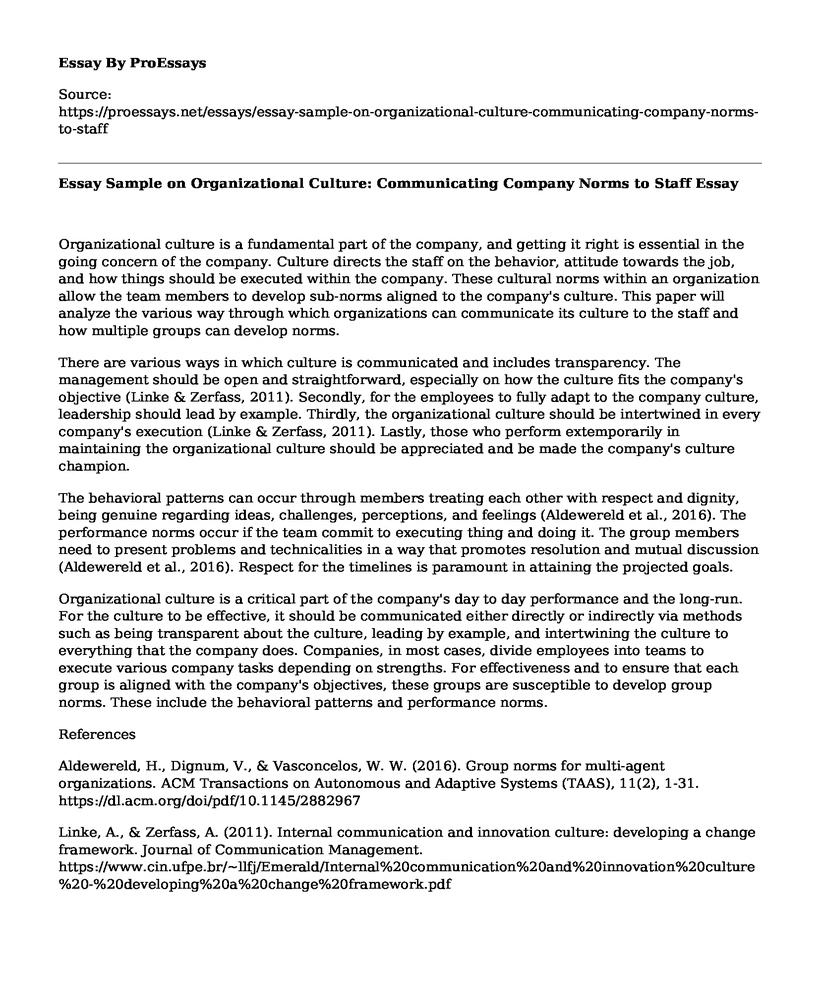Organizational culture is a fundamental part of the company, and getting it right is essential in the going concern of the company. Culture directs the staff on the behavior, attitude towards the job, and how things should be executed within the company. These cultural norms within an organization allow the team members to develop sub-norms aligned to the company's culture. This paper will analyze the various way through which organizations can communicate its culture to the staff and how multiple groups can develop norms.
There are various ways in which culture is communicated and includes transparency. The management should be open and straightforward, especially on how the culture fits the company's objective (Linke & Zerfass, 2011). Secondly, for the employees to fully adapt to the company culture, leadership should lead by example. Thirdly, the organizational culture should be intertwined in every company's execution (Linke & Zerfass, 2011). Lastly, those who perform extemporarily in maintaining the organizational culture should be appreciated and be made the company's culture champion.
The behavioral patterns can occur through members treating each other with respect and dignity, being genuine regarding ideas, challenges, perceptions, and feelings (Aldewereld et al., 2016). The performance norms occur if the team commit to executing thing and doing it. The group members need to present problems and technicalities in a way that promotes resolution and mutual discussion (Aldewereld et al., 2016). Respect for the timelines is paramount in attaining the projected goals.
Organizational culture is a critical part of the company's day to day performance and the long-run. For the culture to be effective, it should be communicated either directly or indirectly via methods such as being transparent about the culture, leading by example, and intertwining the culture to everything that the company does. Companies, in most cases, divide employees into teams to execute various company tasks depending on strengths. For effectiveness and to ensure that each group is aligned with the company's objectives, these groups are susceptible to develop group norms. These include the behavioral patterns and performance norms.
References
Aldewereld, H., Dignum, V., & Vasconcelos, W. W. (2016). Group norms for multi-agent organizations. ACM Transactions on Autonomous and Adaptive Systems (TAAS), 11(2), 1-31. https://dl.acm.org/doi/pdf/10.1145/2882967
Linke, A., & Zerfass, A. (2011). Internal communication and innovation culture: developing a change framework. Journal of Communication Management. https://www.cin.ufpe.br/~llfj/Emerald/Internal%20communication%20and%20innovation%20culture%20-%20developing%20a%20change%20framework.pdf
Cite this page
Essay Sample on Organizational Culture: Communicating Company Norms to Staff. (2023, May 09). Retrieved from https://proessays.net/essays/essay-sample-on-organizational-culture-communicating-company-norms-to-staff
If you are the original author of this essay and no longer wish to have it published on the ProEssays website, please click below to request its removal:
- Giraffe Experience (Leadership and Team Working Skills)
- Case Study of a Company's Output Strategy
- Essay Sample on Corporate Governance
- Article Analysis Essay on "Good to Great" Jim Collins
- Paper Example on OSSTMM: Comprehensive Security Testing Methodology Guide
- Essay Sample on Gap Inc.'s Competitive Strategy: Differentiation & Best-Cost Provider
- Paper Sample on Adapting to Change: Overcoming Challenges in the Business World







